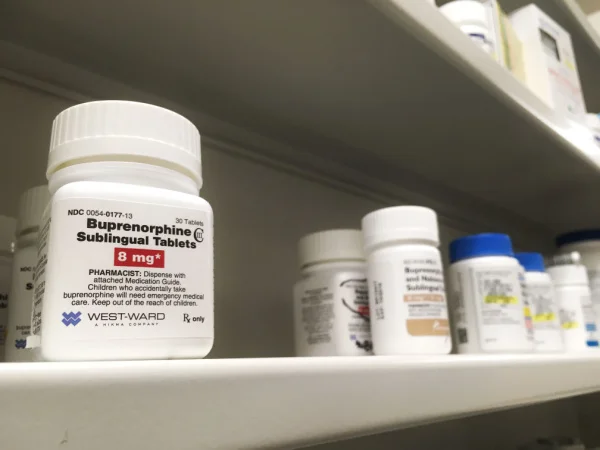Understanding Suboxone Side Effects
For people struggling with opioid use disorder (OUD), addiction treatment can be an important step toward long-term recovery. Prescription treatment medications are commonly used to treat
OUD because they can help reduce the risk of relapse and opioid overdose-related deaths.
One such treatment medication is the sublingual (orally, under the tongue) drug Suboxone, a brand-name medication that combines buprenorphine and naloxone to help:
- Ease withdrawal symptoms
- Reduce cravings
- Prevent the euphoric effects (or the “high”) of opioids
While there are potential Suboxone side effects, people struggling with opioid addiction may benefit from a comprehensive treatment plan while under the care of qualified treatment
professionals.
If you or someone you know is struggling with opioid addiction, it may be helpful to understand what Suboxone is, the common side effects of Suboxone, and where to get addiction treatment.
What Are Suboxone Side Effects?

If you’re considering treatment for OUD, you may be wondering what the most common side effects of Suboxone are.
Common Suboxone side effects can include:
- Headache
- Nausea and vomiting
- Constipation
- Dizziness
- Sweating
- Insomnia
- Blurred vision
- Drowsiness and fatigue
- Dry mouth and related tooth decay
- Muscle pain and cramps
- Dilated pupils
Psychiatric mental health nurse practitioner (PMHNP) Valerie Puffenberger has tips for how to minimize the unpleasant side effects of Suboxone:
- Take Suboxone after a meal or take an antacid to lessen stomach pain. Increase fluid intake, increase fiber intake, and exercise for constipation issues.
- Avoid napping, limit caffeine intake, and maintain a consistent sleep schedule for sleep problems.
- Mild aches and pains can be managed with over-the-counter medications such as ibuprofen.
- If you experience issues with pain or redness in the mouth, switch sides on which you are dissolving the Suboxone you can alternate between the right and left side of the mouth every other day.
Suboxone side effects are commonly associated with buprenorphine, which is one of the active ingredients in Suboxone. Buprenorphine is an opioid receptor partial agonist, meaning it can
cause patients to feel a mild euphoric effect. This effect works to ease withdrawal symptoms and cravings associated with quitting opioids.
You should be aware that there is misuse potential with buprenorphine; however, the presence of naloxone in Suboxone helps to mitigate the euphoric effects of buprenorphine and prevent misuse.
Adverse Side Effects of Suboxone
The above common side effects of Suboxone aren’t typically life-threatening, but there are some adverse effects associated with Suboxone, including:
- Respiratory depression or hypoventilation
- Oral hypoesthesia (loss of sensation)
- Glossodynia (burning sensation in the mouth)
- Oral mucosal redness/swelling
- Peripheral edema (swelling in legs or hands)
If you experience any adverse side effects while using Suboxone, it’s a good idea to contact your doctor or treatment specialist.
Duration of Suboxone Side Effects
The side effects of Suboxone and their duration will vary depending on the person and the severity of their opioid addiction.
Side effects can range from mild to severe but should lessen in intensity over time. Specifically, side effects that are a result of opioid withdrawal, like muscle pain, dilated pupils, and fever, should become less severe with time.
If you are taking Suboxone and experience ongoing side effects or adverse effects, talk to your doctor and treatment team about other options to support your recovery from opioid addiction.
Effects of Suboxone Misuse
The presence of buprenorphine in Suboxone means that it is possible to take too much and potentially overdose.
It’s important to know that buprenorphine is considered safe compared with other types of opioids because its effects are less severe. When taken under the care of your doctor and in proper dosage, over-sedation and slow breathing won’t be as severe, which can lower the potential for overdose.
If a person misuses too much Suboxone or has been abstinent (not using opioids) for an extended period, they may be at a higher risk of an opioid overdose when using Suboxone. If you or someone you know is experiencing an opioid overdose, call 9-1-1 immediately. The following are signs of an opioid overdose:
- Pale and/or clammy face
- The body goes limp
- Blue or purple fingernails
- Vomiting and gurgling noises
- Unable to speak or wake up
- Slowed breathing and heart rate
The risk of significant respiratory depression and overdose can increase if you use Suboxone with benzodiazepines or other depressants, including alcohol.
Differences Between Subutex and Suboxone Side Effects

Subutex is a discontinued brand name formulation of sublingual buprenorphine. Unlike Suboxone, Subutex does not contain naloxone.
Since Subutex is buprenorphine, it has similar side effects to Suboxone, including:
- Constipation
- Headache
- Nausea
- Vomiting
- Dizziness
- Drowsiness and fatigue
- Sweating
- Dry mouth
- Muscle aches and cramps
- Sleep problems
- Fever
- Blurred vision or dilated pupils
- Tremors
- Palpitations
- Difficulty paying attention
However, because Subutex does not contain naloxone, the chances for misuse may be higher compared to Suboxone. Naloxone is an opioid antagonist, meaning it blocks the euphoric
effects of opioids. Because Suboxone contains naloxone, it reduces the chances of misuse.
How Suboxone Works
Suboxone works by placing a sublingual film under the tongue or in the cheek to reduce cravings and withdrawal symptoms related to opioid misuse and addiction. It can also help
prevent or lessen the high people feel when they misuse opioids.
Suboxone should only be taken under the supervision of a doctor and as part of a comprehensive treatment plan to help prevent uncomfortable Suboxone side effects or other adverse effects.
Suboxone can be taken for the short- or long-term, depending on a person’s unique needs and treatment plan.
It’s important to note that people who stop using Suboxone without proper planning or support have a high chance of relapse. Therefore, it is important to continue with the treatment and
discuss with your doctor the possibility and process for discontinuing Suboxone.
There are two different types of medication in Suboxone, which can help people recover from opioid addiction and misuse. These medications are:
- Buprenorphine. This medication is a partial opioid agonist, which means it partially activates opioid receptors in a person’s brain. These are the same receptors activated when a person uses opioids like heroin, oxycodone, and morphine. Partially activating these receptors helps ease uncomfortable withdrawal symptoms and reduce cravings. Small doses may still produce euphoric effects or respiratory depression but with less intensity than opioids considered full opioid agonists. For example, methadone is a full opioid agonist and tends to produce more euphoric effects.
- Naloxone. This medication is an opioid receptor antagonist and is in Suboxone to help prevent misuse. Opioid antagonists block the activation of opioid receptors in the brain, preventing the overly euphoric effect that buprenorphine may bring on.
Get Help for Opioid Addiction
If you or a loved one struggles with opioid addiction, help is available. At Legacy, we take a holistic approach to addiction treatment and have helped many people recover from OUD. Call
us to learn more about how we use medications like Suboxone along with psychological counseling to help treat opioid addiction.
FAQs
What are Suboxone side effects?
- Headache
- Nausea and vomiting
- Constipation
- Dizziness
- Sweating
- Insomnia
- Drowsiness and fatigue
How long do Suboxone side effects last?
What is the difference between Subutex and Suboxone side effects?
Sources
- National Institute on Drug Abuse. (n.d.). Medications for opioid overdose, withdrawal, & addiction.
- Substance Abuse and Mental Health Services Administration. (2021). Medications for opioid use disorder. Treatment Improvement Protocol (TIP) Series 63 Publication No. PEP21-02-01-002. Rockville, MD: Substance Abuse and Mental Health Services Administration.
- Substance Abuse and Mental Health Services Administration. (2022, April 21). Buprenorphine.
- Suboxone.com. (2022, June). Prescribing information | SUBOXONE® (buprenorphine and naloxone) sublingual film (CIII).
- Substance Abuse and Mental Health Services Administration. (2023, March 21). Opioid Overdose.
- Drug Enforcement Administration. (2022, May). Buprenorphine.
- Substance Abuse and Mental Health Services Administration. (2023, June 20). Buprenorphine.


